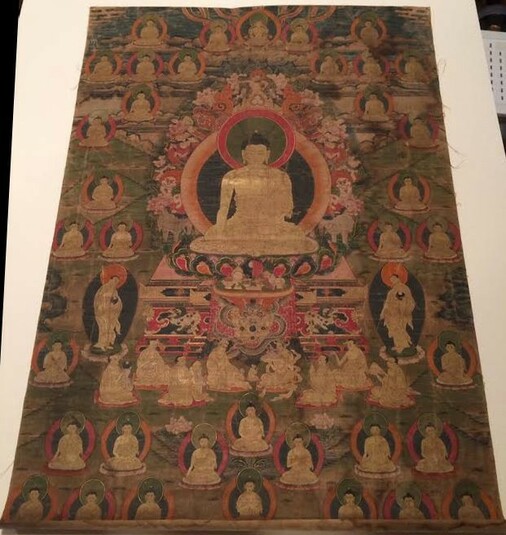
Item: Shakyamuni Buddha
| Origin Location | Tibet |
|---|---|
| Lineages | Buddhist |
| Material | Gold Background on Cotton |
| Collection | Private |
Classification: Person
Shakyamuni Buddha (Tibetan: sha kya tu pa, sang gye. English: the Enlightened One, Sage of the Shakya Clan) together with the two principal students, Shariputra and Maudgalyayana, standing at the sides while surrounded by the Thirty-five Confession Buddhas. (See the Thirty-five Confession Buddhas Main Page).
At the center of the composition is Shakyamuni Buddha seated on an elaborate lion supported thorn with a decorative 'torana.' The two principal disciples Shariputra and Maudgalyayana stand at his proper right and left sides.
Seated directly in front of the throne are various arhats, stahvira, pratyekabuddhas and devas.
At the top center is Amitabha/Amitayus Buddha flanked by the previous Buddha Dipamkara and the future Buddha Maitreya.
Surrounding the central image of Shakyamuni Buddha are the Thirty-five Confession Buddhas in which Shakyamuni is also included. The three buddhas at the top center are not members of the group of thirty-five.
On the reverse of the painting there are several Sanskrit language inscriptions written in the Nepalese Lantsa script. The first is the mantra for Shakyamuni Buddha - 'om muni muni mahamuniye svaha.' The second is the basic 'ye dharma hetunte...' Sanskrit verse and the third is the mantra to make the blessing for the painting firm and stable 'om supratishtaye svaha.'
The Sutra of the Three Heaps, in Sanskrit the Trīskhandhadharmasūtra, or briefly the Triskandha Sutra (phung po gsum pa'i mdo), is a Mahayana ritual text used primarily by monks and nuns for the purpose of confession of downfalls which means transgressions against the vinaya and bodhisattva vows. The central object of worship is the Thirty-five Confession Buddhas, including Shakyamuni Buddha. The name of the sutra follows from the three principal sections of the text: 1) homage, 2) confession, and 3) and dedication. There are other texts on confession found in the various Mahayana Sutras however none of those appear to have any representations in Himalayan and Tibetan art.
There are two traditions of Mahayana Buddhism that include the Thirty-five Confession Buddhas as a key element in ritual and visualization practice. The two are the Yogachara and Madhyamaka philosophical systems of Mahayana Buddhism. Two distinct ritual systems for bestowing the Bodhisattva Vows have developed from these two traditions and both incorporate the visualization of the Thirty-five Buddhas along with the recitation of the Confession Sutra.
In Himalayan and Tibetan art there are at least three different iconographic systems for depicting the individual Thirty-five Confession Buddhas. The principal authors of commentaries and ritual texts were Nagarjuna (not necessarily the famous Nagarjuna), Sakya Pandita and Je Tsongkapa along with a number of others. The TBRC website lists approximately sixty texts associated with the practice of the Confession Buddhas.
Jeff Watt 2-2014
Reverse of Painting
Wylie Transliteration of Inscription: [Lantsa script] om muni muni maha muniye svaha. om ye dharma hetunte...... om supra tishta ye svaha.
Special Features: (Ranjana script (Ornamental Sanskrit), is gold)
Subject: Thirty-five Confession Buddhas Main Page
Shakyamuni Buddha: Main Page
Painting Type: Gold Fill Paintings

